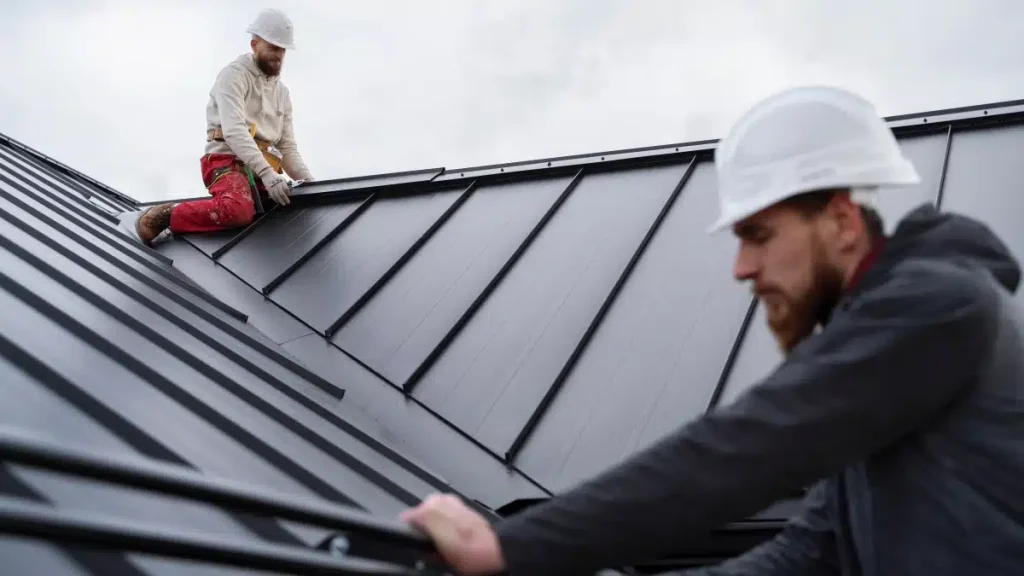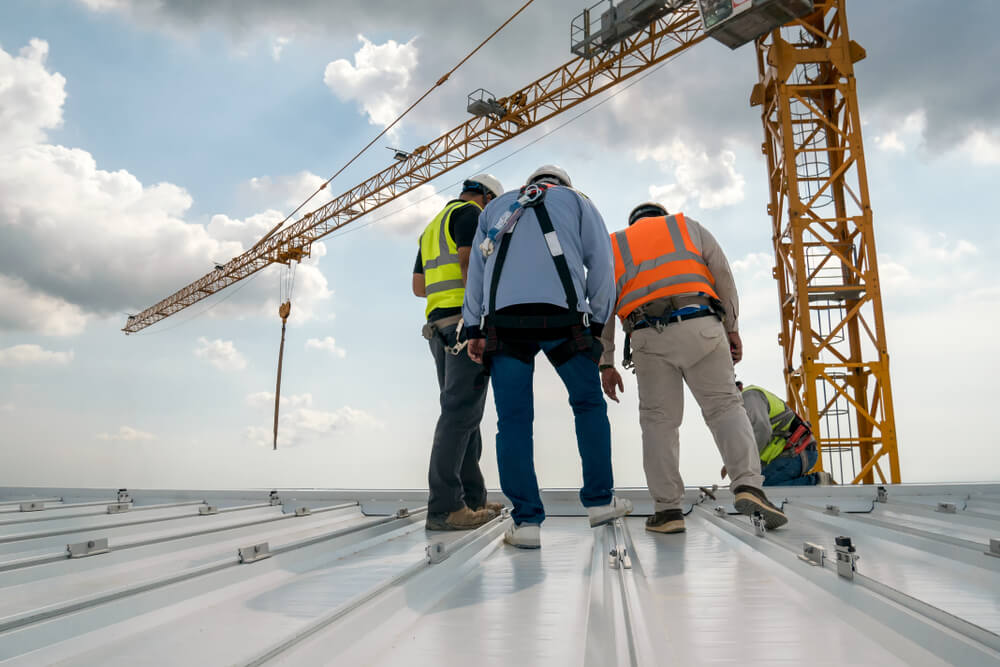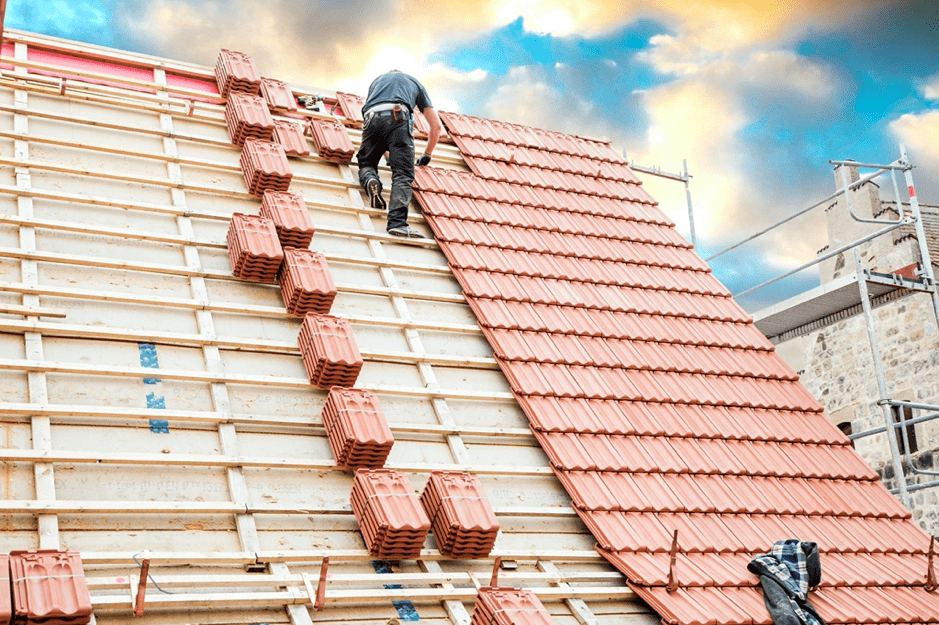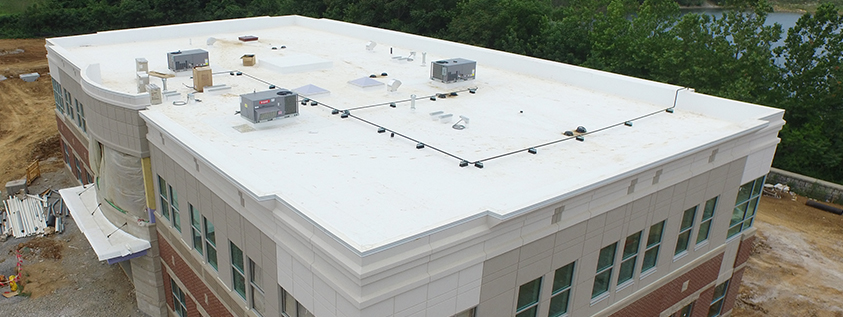Choosing the right roofing material for your commercial building is key to long-lasting protection and cost-efficiency.
With various materials offering different benefits, it’s important to choose one that suits your specific needs.
In this guide, we’ll explore the top commercial roofing materials, factors to consider, and how to make the best choice for your building.
What is the best commercial roofing material?
The best commercial roofing material depends on your building’s needs. Popular options include TPO, EPDM, and metal, all offering durability and energy efficiency for commercial spaces.
Key Takeaways
- The best commercial roofing material depends on factors such as climate, building size, and budget.
- Popular commercial roofing materials include TPO, EPDM, metal roofing, and modified bitumen.
- Each material has distinct benefits, and understanding these can help make an informed decision for your building.
Why Choosing the Right Commercial Roofing Material Is Important

The roof of a commercial building is a critical component of its structure, providing essential protection against the elements.
A durable and well-chosen roofing system not only safeguards the building’s structure and contents but also significantly influences the building’s overall energy efficiency, comfort, and longevity.
When it comes to commercial buildings, choosing the right roofing material is crucial for long-term durability, cost-effectiveness, and protection from the elements.
Different types of commercial roofing materials offer unique benefits and can be better suited to specific needs.
We’ll explore the best commercial roofing materials, factors to consider when making a decision, and how to ensure you choose the right material for your building.
Given the roof’s important role, it is essential to select the right material for your commercial roofing project to avoid costly repairs, operational inefficiencies, and potential safety hazards.
1. Protection and Durability
The primary function of any commercial roof is to protect the building from the elements, including rain, wind, snow, and extreme temperatures.
Choosing a roofing material that is durable and weather-resistant is crucial in ensuring the building remains safe and secure.
A roof that is improperly suited for its environment may degrade quickly, leading to leaks, water damage, and other structural issues that can affect the interior of the building.
For example, a roof that is not designed to withstand high winds could be torn apart during a storm, leading to extensive damage and expensive repairs.
The type of material chosen directly impacts the roof’s ability to endure harsh weather conditions.
For instance, metal roofing materials are known for their durability and resistance to both wind and water.
Similarly, certain types of rubber or TPO roofing are designed to be highly resistant to water and UV rays, providing long-lasting protection for commercial buildings.
2. Energy Efficiency and Cost Savings
Beyond protecting the building, the roof is an essential factor in regulating the building’s internal temperature.
A well-chosen roofing material can significantly reduce energy costs by improving insulation and reflecting heat away from the building.
Energy-efficient roofs help maintain a comfortable indoor environment, reducing the need for heating and cooling systems to work overtime, which can lower utility bills over time.
For instance, cool roofing materials, such as white or reflective coatings, are designed to reflect sunlight and absorb less heat.
This can be especially beneficial in commercial buildings located in hot climates, as it reduces the heat island effect and helps maintain lower interior temperatures.
Similarly, insulated roofing systems help to keep the building’s internal temperature stable, reducing the demand on HVAC systems and contributing to energy efficiency.
Choosing a roofing material that enhances energy efficiency will not only benefit the building’s comfort but can also result in long-term financial savings.
Many businesses are also eligible for tax incentives and rebates for installing energy-efficient roofing systems, making it a financially savvy choice.
3. Long-Term Investment
The roof is one of the most significant investments a commercial property owner will make, and its longevity directly affects the financial stability of the business.
The wrong roofing material may lead to frequent repairs, resulting in additional costs over time.
An improper roofing system can also decrease the overall value of the property, which can impact its marketability if the property is sold or leased in the future.
On the other hand, selecting a high-quality, durable roofing material for your commercial building can extend the lifespan of the roof, often for several decades.
Many modern roofing materials come with warranties that last 20 years or more, giving you peace of mind knowing that your roof is built to last.
Furthermore, a well-maintained roof can improve the curb appeal of the building and enhance its market value, ensuring that the initial investment pays off in the long run.
4. Safety Considerations
Safety should always be a top priority when selecting roofing materials for a commercial property.
Some roofing materials are more fire-resistant than others, which is a critical consideration, particularly for buildings that house hazardous materials or are located in areas prone to wildfires.
Fire-resistant materials such as metal, modified bitumen, or clay tiles can provide better protection against fire hazards.
In addition to fire resistance, the chosen roofing material should provide adequate load-bearing capacity to support the weight of the structure and any potential snow or debris accumulation.
Choosing a roof that is designed to handle local weather conditions and potential environmental stresses can help prevent structural failures that could pose safety risks to building occupants.
5. Choosing the Right Commercial Roofing Material
Several factors must be considered when selecting the ideal commercial roofing material. Here are some key considerations:
Climate: The local climate plays a significant role in determining which roofing material will be the most effective.
For example, a building located in a hot, sunny area may benefit from a reflective roof, while a building in a region prone to heavy rain or snow may require a waterproof and insulated roof.
Building Type: The type of building also influences roofing material choice.
For example, flat roofs are often better suited for materials like TPO or EPDM, while sloped roofs may benefit from materials like metal or asphalt shingles.
Maintenance: Some roofing materials require more frequent maintenance than others.
For example, metal roofing may require less maintenance than asphalt shingles, which may need to be replaced or repaired more frequently.
Budget: Roofing materials vary widely in cost, and the price can impact the overall project budget.
While high-end materials like slate or copper may offer long-term durability, they can be costly upfront. Balancing cost with durability and energy efficiency is key.
Environmental Impact: Sustainability is an important factor for many businesses today.
Eco-friendly roofing materials, such as cool roofs or green roofs, help reduce the environmental footprint of a building while also offering energy-saving benefits.
Choosing the right commercial roofing material is crucial for the long-term protection, energy efficiency, and safety of your building.
A well-chosen roof not only protects the building’s structure and enhances its value but also helps improve energy efficiency and reduce ongoing maintenance costs.
Whether you are building a new commercial property or replacing an old roof, take the time to carefully assess your options, consider your building’s unique needs, and consult with professional roofers to ensure the best material is selected.
Investing in the right roofing system is an investment in the future of your business, providing lasting protection, cost savings, and peace of mind.
Factors to Consider When Choosing a Commercial Roofing Material


Before settling on a specific roofing material, there are several important factors to consider:
1. Climate and Weather Conditions
The local climate plays a vital role in choosing the right roofing material.
If you live in an area that experiences extreme temperatures, heavy rains, or strong winds, you’ll need a roofing material that can withstand those conditions.
For example, metal roofing is ideal for areas with heavy snowfall, while TPO (Thermoplastic Olefin) is well-suited for hot climates due to its heat-reflective properties.
2. Durability and Lifespan
Different roofing materials offer varying levels of durability.
Some materials, such as metal, are known for their long lifespan and resistance to damage, while others, like EPDM roof material (Ethylene Propylene Diene Monomer), may require more frequent maintenance.
When choosing a material, consider how long you want the roof to last and the level of maintenance you’re willing to perform.
3. Budget Considerations
Roofing materials come with a range of prices. Some, like TPO and EPDM, are more affordable upfront, but may not last as long as higher-end materials like metal roofing or modified bitumen.
Be sure to factor in the long-term costs of repair and maintenance when creating your budget.
4. Installation and Maintenance Costs
The cost of installation can vary depending on the material chosen.
While metal roofing might have a higher upfront cost, its long lifespan and low maintenance needs may make it a more cost-effective option in the long run.
For homeowners considering this option, it’s also worth understanding related elements—such as how to install gutters on a metal roof—since proper gutter installation can help protect your investment and improve drainage.
On the other hand, materials like modified bitumen may have lower installation costs but could require more maintenance over time.
Top Commercial Roofing Materials to Consider


Several roofing materials are commonly used in commercial applications. Here are some of the top choices and their unique benefits:
1. TPO (Thermoplastic Olefin)
TPO is a popular choice for flat commercial roofs due to its affordability, energy efficiency, and ease of installation.
This single-ply roofing membrane is known for its reflective surface, which helps keep buildings cool and reduces energy costs.
TPO is also resistant to UV rays, ozone, and chemical exposure, making it ideal for buildings in harsh climates.
Pros:
- Affordable installation and material costs
- Reflective surface reduces energy bills
- Resistant to UV rays and ozone
Cons:
- Shorter lifespan compared to other materials (15-20 years)
- Prone to punctures and damage in certain conditions
2. EPDM (Ethylene Propylene Diene Monomer)
EPDM is a durable, rubber-like roofing material known for its flexibility and weather resistance.
It is ideal for flat or low-slope roofs and provides excellent protection against extreme weather conditions, including rain, snow, and high winds.
EPDM is a popular choice for commercial buildings in areas with heavy rainfall or unpredictable weather.
Pros:
- Long lifespan (up to 30 years)
- Excellent resistance to extreme weather conditions
- Low maintenance requirements
Cons:
- Dark surface can absorb heat, making it less energy-efficient in warm climates
- Requires professional installation
3. Metal Roofing
Metal roofing is one of the most durable and long-lasting options for commercial buildings.
Available in a variety of materials, including steel, aluminium, and copper, metal roofing is known for its resistance to fire, wind, and water.
It is also an environmentally friendly option, as metal roofs are often made from recycled materials and are fully recyclable at the end of their life.
Pros:
- Extremely durable (can last 40-70 years)
- Fire and weather-resistant
- Energy-efficient and eco-friendly
Cons:
- Higher upfront costs compared to other materials
- Noisy during rain or hail (unless insulated)
4. Modified Bitumen
Modified bitumen is a type of asphalt roofing material that has been enhanced with polymers to increase its strength and flexibility.
It is commonly used for flat or low-slope commercial roofs and is known for its excellent waterproofing properties.
Modified bitumen is also relatively affordable, making it an attractive option for budget-conscious building owners.
Pros:
- Affordable compared to other materials
- Strong waterproofing capabilities
- Easy to install and repair
Cons:
- Shorter lifespan than other materials (10-20 years)
- Requires regular maintenance to prevent damage
5. Green Roofing (Living Roofs)
Green roofing, also known as living roofs, is an environmentally friendly option that involves covering the roof with vegetation.
This roofing solution offers excellent insulation, reduces urban heat island effects, and helps manage stormwater runoff.
While green roofs are not common for all commercial buildings, they are a great option for businesses looking to reduce their environmental footprint.
Pros:
- Environmentally friendly and energy-efficient
- Excellent insulation properties
- Helps manage stormwater
Cons:
- High installation and maintenance costs
- Requires structural considerations to support the weight of plants and soil
How to Choose the Right Commercial Roofing Material for Your Building


Selecting the right roofing material for your commercial property requires careful consideration of several factors, including your location, budget, and the specific needs of your building.
Here’s a step-by-step approach to making an informed decision:
1. Assess Your Building’s Needs
Consider the size, shape, and purpose of your commercial building.
Flat roofs may be best suited to materials like EPDM or TPO, while sloped roofs may be better suited to metal roofing or modified bitumen.
2. Evaluate Your Budget
Understand both your upfront costs and long-term maintenance requirements. While some materials are less expensive initially, they may require more maintenance and repairs over time.
3. Consider Local Climate and Weather Conditions
Take into account the weather patterns in your area. If your business is located in an area with heavy rainfall or extreme temperatures, select a material that is resistant to those conditions.
4. Consult a Professional
Consult with a roofing contractor who can assess your building’s specific needs and recommend the best material.
A professional can also help you navigate the installation process and ensure your roof is installed correctly.
Frequently Asked Questions
1. What is the most durable roofing material for commercial buildings?
Metal roofing is known for its durability and can last 40-70 years, making it one of the most reliable options for commercial buildings.
2. How much does it cost to install a commercial roof?
The cost of installing a commercial roof can vary widely, depending on the size of the building and the material chosen. On average, expect to pay between $5,000 and $15,000 for installation.
3. How long do commercial roofs typically last?
The lifespan of a commercial roof depends on the material. Metal roofs can last 40-70 years, while materials like TPO and EPDM typically last 15-30 years.
Conclusion
Choosing the best commercial roofing material is essential for the long-term protection and performance of your building.
Whether you opt for durable metal roofing, energy-efficient TPO, or a green roofing solution, it’s important to consider factors like climate, cost, and maintenance needs. For example, when selecting metal roofing, understanding the typical metal roofing panel width can help you plan for proper installation and overall design efficiency.
Taking the time to assess your options and consult with a professional can help ensure your commercial roof system meets the demands of your building while staying within your budget.
No matter what material you choose, maintaining your roof with regular inspections and upkeep will help extend its lifespan and protect your investment.








